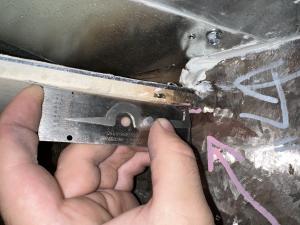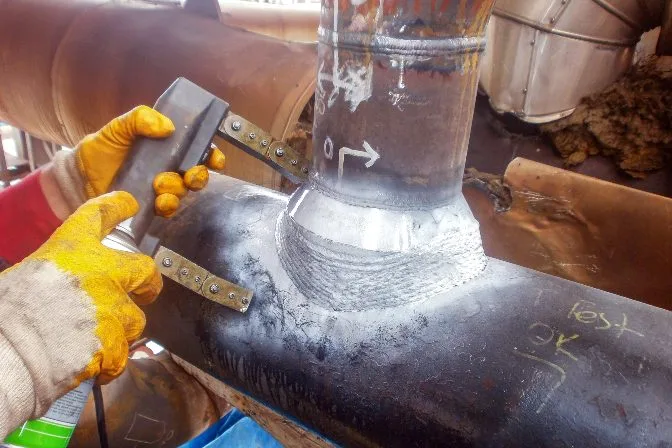How to Guarantee Quality with Welding Inspection Gilbert Arizona: Ideal Practices
How to Guarantee Quality with Welding Inspection Gilbert Arizona: Ideal Practices
Blog Article
A Comprehensive Overview to Welding Examination: Recognizing Standards, Techniques, and Ideal Practices for Quality Guarantee
Welding inspection plays a pivotal duty in making certain the architectural stability and security of welded components, necessitating a comprehensive understanding of industry standards such as those developed by AWS and ASME. Different assessment techniques, including ultrasonic and aesthetic testing, are employed to detect possible flaws that might compromise top quality. Carrying out finest practices can dramatically improve operational dependability and foster count on amongst clients. As we explore these essential aspects, it becomes obvious that the implications of welding examination prolong far past compliance, welcoming a closer exam of exactly how these processes shape industry requirements and practices.
Importance of Welding Assessment
Welding examination plays an important duty in ensuring the integrity and security of bonded frameworks. It is an essential process that verifies that welds adapt to predefined requirements, which is vital in various markets, including building, vehicle, and aerospace. By performing thorough evaluations, prospective problems such as fractures, incomplete combination, and porosity can be determined early, stopping disastrous failings that might cause crashes or expensive repair services.
The value of welding examination expands past plain conformity with laws; it additionally promotes depend on with stakeholders. Clients and regulative bodies expect assurance that the frameworks they count on are constructed to stand up to functional anxieties. Moreover, efficient welding inspection practices contribute to lasting longevity and efficiency of the structures, eventually resulting in reduced upkeep expenses.
In addition, welding assessment promotes a society of high quality within companies, motivating adherence to best techniques and constant renovation. By integrating inspection procedures into the welding workflow, business can enhance their track record and establish themselves as leaders in quality control. Finally, the importance of welding examination depends on its ability to secure lives, ensure architectural reliability, and maintain sector requirements, making it an essential element of welding procedures.
Secret Sector Standards
Making sure conformity with essential sector standards is important for keeping the quality and security of bonded frameworks. Various organizations develop these criteria to promote best methods in welding and examination - Welding Inspection Gilbert Arizona. Among the most acknowledged are the American Welding Culture (AWS) and the American Culture of Mechanical Engineers (ASME), which offer in-depth standards and requirements for welding processes and evaluation requirements
AWS criteria, such as AWS D1.1 for architectural welding, outline demands for materials, style, and screening to make certain the stability of welds. ASME codes, consisting of ASME Section IX, govern the qualification of welders and welding procedures, guaranteeing constant high quality in industrial applications. Globally, the ISO 3834 conventional highlights high quality demands for combination welding, offering a framework for organizations to demonstrate conformity with international ideal techniques.
Conformity with these requirements not only enhances the integrity of bonded frameworks however also reduces risks connected with architectural failings. Adherence to market standards is often a requirement for regulative approvals and can significantly affect project specifications. Inevitably, understanding and executing these key criteria are necessary for effective welding examination and top quality assurance.
Examination Techniques Introduction
Effective welding examination depends on a variety of methods designed to analyze the high quality and honesty of welds. These methods can be generally categorized right into non-destructive and devastating testing (NDT) approaches. Non-destructive testing methods, which are widely liked in the industry, enable for the evaluation of welds without jeopardizing the honesty of the material.

Among the most frequently utilized NDT methods are aesthetic assessment, ultrasonic screening, radiographic screening, and magnetic bit testing. Visual evaluation is typically the very first step in the assessment process, enabling inspectors to identify surface area blemishes and assess weld bead accounts.
Each strategy has its very own advantages and limitations, making it important for inspectors to select the most appropriate technique based on the details needs of the task, the products included, and the criticality of the welds being checked. This mindful choice promotes and makes sure extensive assessments safety and security and high quality standards in welding procedures.
Typical Problems and Their Implications
A thorough understanding of usual problems in welds is essential for keeping structural integrity and safety and security in welded building and constructions. Welding problems can significantly endanger the mechanical residential properties of the joint, resulting in failings that might jeopardize both workers and tools.
Common issues include porosity, which shows up as small gas pockets entraped in the weld metal, deteriorating the overall structure. Fracturing is one more widespread issue, commonly arising from fast air conditioning or improper joint style, bring about tension focus that can result in devastating failings. Insufficient fusion happens when the weld steel fails to correctly bond with the base product, developing weak points that may bring about splitting up under load.
Various other remarkable defects include undercutting, where the weld grain deteriorates the base steel, useful reference and slag inclusions, which can hinder the weld's stamina. Each of these flaws has details implications; for example, porosity can decrease ductility, while splitting straight influences tensile toughness. Identifying and understanding these problems during evaluation is necessary for making sure and carrying Your Domain Name out rehabilitative procedures conformity with sector requirements, eventually securing the structural stability of welded assemblies.
Best Practices for Quality Guarantee
Applying ideal techniques for high quality assurance in welding processes is important for achieving optimal outcomes and lessening flaws. One vital method is the facility of clear welding treatments that comply with market standards and requirements. These treatments must include detailed guidelines relating to material selection, joint prep work, and welding methods to ensure uniformity and high quality.
Regular training and qualification of welding workers are also essential. Knowledgeable welders that understand the relevance of high quality assurance are extra likely to generate sound welds. Additionally, carrying out a robust examination program, including both aesthetic and non-destructive screening (NDT), can assist recognize problems early while doing so, permitting prompt restorative activities.

Last but not least, fostering a culture of high quality within the organization motivates staff members to focus on top quality in their job. By sticking to these ideal practices, organizations can enhance the integrity of their welding processes, ultimately resulting in enhanced product high quality and minimized expenses connected with rework and repair services.

Verdict
In final thought, welding inspection plays an essential function in guaranteeing the integrity and safety and security of welded structures. By carrying out finest practices, companies can enhance integrity, lessen maintenance prices, and cultivate trust amongst clients, inevitably contributing to effective welding operations.
Furthermore, welding examination promotes a society of quality within organizations, urging adherence to best techniques and continuous enhancement. In verdict, the significance of welding assessment exists in its capability to secure lives, ensure architectural integrity, and copyright market standards, making it an important facet of welding procedures.
Among the most acknowledged are the American Welding Culture (AWS) and the American Culture of Mechanical Designers (ASME), which provide comprehensive standards and requirements for welding procedures and inspection criteria.
Eventually, understanding and carrying out these vital standards are important for efficient welding assessment and top quality guarantee.
Reliable welding examination relies on a variety of techniques developed to evaluate the high quality and stability of welds.
Report this page